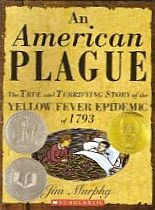Leo T. reviewed An American Plague: The True and Terrifying Story of the Yellow Fever Epidenic of 1793 on + 1775 more book reviews
This is a good introduction to historical books and was picked up by Scholastic three years after being published. While there are no footnotes, there is considerable text broken up by well-chosen illustrations from the time. It includes a bibliography divided into sections by subject for ease of follow up, a note on the illustrations, and index.
The committee constructed a building to nurse those stricken and were very lucky to secure the services of a French doctor, Jean Deveze, with experience in the West Indies. He himself had survived two bouts of yellow fever and prescribed a regimen of good nursing to allow the patients to gather their strength rather than bleedings and harsh medications. This served only Bush Hill and the death rate continued to rise in other sections of Philadelphia.
Note the page reproduced from the Federal Gazette (p.66, October ?, 1793) with commercial ads including goods, ships seeking cargo, estate settlements, and a runaway slave.
"Hodge then pointed out that the deaths, including his daughter's, had all happened on or near Water Street. Foulke told of other deaths along the street and said he knew the origin of the fevers: the repulsive smell in the air cause by the rotting coffe on Ball's Wharf. The idea that ilness was caused by microscopic organisms, such as bacteria and viruses, was not known at the time. Instead, doctors based their medical thinking on the 2,500 year old Greek humoral theory. This concept stated that good health resulted when bodily fluids, called humors, were in balance. The humors were phlegm, choler, bile, and blood."
NYC had yellow fever epidemics every year (1791-1821) and when one hit in 1858 after a couple decades of respite, a mob removed the sick from the Quarantine House and burned it. Mr. Murphy points out that no more was known about treatment in 1858 than in 1793.
The author follows up with the later identification of the mosquito vector and ends by urging readers to consider the future when 'another version' of the disease will arrive.
It does not mention that the U.S. Mint was closed more than once by yellow fever. I myself learned of the severity of yellow fever epidemics as a junior high school student when I found Frank M. Stewart's 1924 book on the shelf at Glendale Public Library (sadly discarded long since although I urged them to retain it). He was the owner of Stewart Electric and purchased the old building (the mint relocated in 1836 when steam coining presses were introduced). He shares what they found as they demolished the building and what he learned of the early days of the mint through historical research.
The committee constructed a building to nurse those stricken and were very lucky to secure the services of a French doctor, Jean Deveze, with experience in the West Indies. He himself had survived two bouts of yellow fever and prescribed a regimen of good nursing to allow the patients to gather their strength rather than bleedings and harsh medications. This served only Bush Hill and the death rate continued to rise in other sections of Philadelphia.
Note the page reproduced from the Federal Gazette (p.66, October ?, 1793) with commercial ads including goods, ships seeking cargo, estate settlements, and a runaway slave.
"Hodge then pointed out that the deaths, including his daughter's, had all happened on or near Water Street. Foulke told of other deaths along the street and said he knew the origin of the fevers: the repulsive smell in the air cause by the rotting coffe on Ball's Wharf. The idea that ilness was caused by microscopic organisms, such as bacteria and viruses, was not known at the time. Instead, doctors based their medical thinking on the 2,500 year old Greek humoral theory. This concept stated that good health resulted when bodily fluids, called humors, were in balance. The humors were phlegm, choler, bile, and blood."
NYC had yellow fever epidemics every year (1791-1821) and when one hit in 1858 after a couple decades of respite, a mob removed the sick from the Quarantine House and burned it. Mr. Murphy points out that no more was known about treatment in 1858 than in 1793.
The author follows up with the later identification of the mosquito vector and ends by urging readers to consider the future when 'another version' of the disease will arrive.
It does not mention that the U.S. Mint was closed more than once by yellow fever. I myself learned of the severity of yellow fever epidemics as a junior high school student when I found Frank M. Stewart's 1924 book on the shelf at Glendale Public Library (sadly discarded long since although I urged them to retain it). He was the owner of Stewart Electric and purchased the old building (the mint relocated in 1836 when steam coining presses were introduced). He shares what they found as they demolished the building and what he learned of the early days of the mint through historical research.




